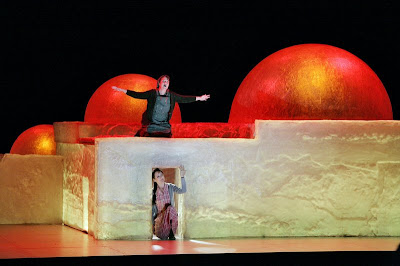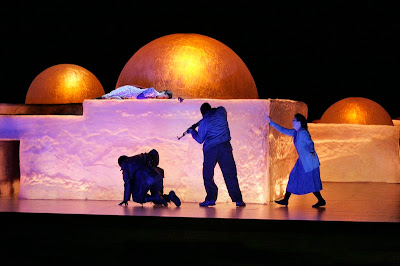 Monica Groop (Adriana, below) and Pia Freund (Refka, above) in Adriana Mater, directed by Peter Sellars, Santa Fe Opera, 2008 (photo © Ken Howard) |
The libretto by Amin Maalouf is set in a village before and after a devastating war. No nationality or location is specified, and the enemy force that threatens is identified only as les autres, the others. The character names and other minor details make the Serbian-Bosnian conflict the likely background (something confirmed by Maalouf), but the idea is that the story could easily be imagined in any number of wartorn areas. (Maalouf, raised in French Catholic schools in his native Lebanon, has lived in France since the 1970s and writes in French: so the themes of homelessness and civil strife have a background in Lebanon, too.) George Tsypin's sets, made of sculpted resin, glow with light like burning embers or reflect it like dull metal or stone, recalling the domes of mosques or Eastern Orthodox churches. In the second act, most of the village walls have been reduced to rubble, the only real reference to the warfare that has occurred in the time elapsed between the rape of the central character, Adriana, and the birth of her son, Yonas.
 Monica Groop (Adriana) and Pia Freund (Refka) in Adriana Mater, sets by George Tsypin, Santa Fe Opera, 2008 (photo © Ken Howard) |
 Monica Groop (Adriana), Matthew Best (Tsargo), Pia Freund (Refka), and Joseph Kaiser (Yonas) in Adriana Mater, Santa Fe Opera, 2008 (photo © Ken Howard) |
 Monica Groop (Adriana) and Joseph Kaiser (Yonas) in Adriana Mater, Santa Fe Opera, 2008 (photo © Ken Howard) |
Craig Smith, ‘Adriana’ has plenty of depth, heft (Santa Fe New Mexican, July 28) Anthony Tommasini, Compassion, Not Revenge, After a Rape in a War Zone (New York Times, August 1) Scott Cantrell, Santa Fe Opera premieres arresting war story, 'Adriana Mater' (Dallas Morning News, August 1) Anne Midgette, Promising 'Adriana' Could Use a Drama Lesson (Washington Post, August 4) George Loomis, Adriana Mater, Santa Fe Opera (Financial Times, August 4) |
For all of Saariaho's association with IRCAM and the French spectralists, it is the orchestral music of Sibelius that seems the most important influence. At more than a few points, as magisterial brass spiked their heads through the texture, similar moments in Sibelius's symphonies came to mind. The comparison puts me in mind of what Saariaho said about Adriana during the symposium, that it was the dream sequences she most relished, as they allowed her to turn her ear from the horrors of the story's oppressive reality. Noting that she has a complex dream life herself, Saariaho said that no matter how long she has lived in Paris, her dreams are always set in Finland.
Kaija Saariaho's Adriana Mater will be repeated at Santa Fe Opera on July 30 (tonight) and August 8 and 12.
Thank you for this thoughtful review of an important American operatic premiere.
ReplyDelete